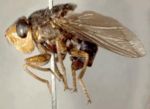Dermatobia hominis
| Dermatobia hominis | |
|---|---|
| Class | Secernentea |
| Order | Diptera |
| Family | Oestridae |
| Genus | Dermatobia |
| Species | D. hominis |
Also known as: Human bot fly — Torsalo — Berne — Ura
Hosts
Humans, many birds and most domestic and wild animals.
Identification
The mature larvae may grow up to 25mm in length. D. hominis are similar to Calliphora in appearance, and are of the family Oestridae. They have a blue-black abdomen, and have yellow-orange head and legs.
Larvae are distinctive as they taper towards the posterior end.
Life cycle
The adults do not feed, and draw food from the larvae stage, which accumulate stores throughout their development. The female then catches an insect, most commonly the mosquito, and lays a batch of eggs on it.
The insect lands on a host, and the L1 larvae then hatch on the host, and quickly penetrate the skin. The larvae undergo a transformation to L2, and then subsequently to L3. The larvae fully mature, and then move to the ground to pupate. They then emerge later as adults.
It is a 4 month life cycle.
| Dermatobia hominis Learning Resources | |
|---|---|
 Test your knowledge using flashcard type questions |
Myiasis Producing Flies Flashcards |
 Search for recent publications via CAB Abstract (CABI log in required) |
Dermatobia hominis publications |
References
Taylor, M.A, Coop, R.L., Wall,R.L. (2007) Veterinary Parasitology Blackwell Publishing
| This article has been peer reviewed but is awaiting expert review. If you would like to help with this, please see more information about expert reviewing. |
Error in widget FBRecommend: unable to write file /var/www/wikivet.net/extensions/Widgets/compiled_templates/wrt694d5fec2f5885_72428332 Error in widget google+: unable to write file /var/www/wikivet.net/extensions/Widgets/compiled_templates/wrt694d5fec4302e5_19108114 Error in widget TwitterTweet: unable to write file /var/www/wikivet.net/extensions/Widgets/compiled_templates/wrt694d5fec537126_66232620
|
| WikiVet® Introduction - Help WikiVet - Report a Problem |

